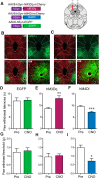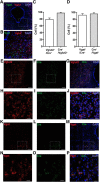Divergent Modulation of Nociception by Glutamatergic and GABAergic Neuronal Subpopulations in the Periaqueductal Gray
- PMID: 28374016
- PMCID: PMC5370278
- DOI: 10.1523/ENEURO.0129-16.2017
Divergent Modulation of Nociception by Glutamatergic and GABAergic Neuronal Subpopulations in the Periaqueductal Gray
Abstract
The ventrolateral periaqueductal gray (vlPAG) constitutes a major descending pain modulatory system and is a crucial site for opioid-induced analgesia. A number of previous studies have demonstrated that glutamate and GABA play critical opposing roles in nociceptive processing in the vlPAG. It has been suggested that glutamatergic neurotransmission exerts antinociceptive effects, whereas GABAergic neurotransmission exert pronociceptive effects on pain transmission, through descending pathways. The inability to exclusively manipulate subpopulations of neurons in the PAG has prevented direct testing of this hypothesis. Here, we demonstrate the different contributions of genetically defined glutamatergic and GABAergic vlPAG neurons in nociceptive processing by employing cell type-specific chemogenetic approaches in mice. Global chemogenetic manipulation of vlPAG neuronal activity suggests that vlPAG neural circuits exert tonic suppression of nociception, consistent with previous pharmacological and electrophysiological studies. However, selective modulation of GABAergic or glutamatergic neurons demonstrates an inverse regulation of nociceptive behaviors by these cell populations. Selective chemogenetic activation of glutamatergic neurons, or inhibition of GABAergic neurons, in vlPAG suppresses nociception. In contrast, inhibition of glutamatergic neurons, or activation of GABAergic neurons, in vlPAG facilitates nociception. Our findings provide direct experimental support for a model in which excitatory and inhibitory neurons in the PAG bidirectionally modulate nociception.
Keywords: DREADDs; Descending modulation; PAG; RVM; chemogenetics; pain.
Figures





Similar articles
-
Tumor necrosis factor-α modulates GABAergic and dopaminergic neurons in the ventrolateral periaqueductal gray of female mice.J Neurophysiol. 2021 Dec 1;126(6):2119-2129. doi: 10.1152/jn.00251.2021. Epub 2021 Nov 24. J Neurophysiol. 2021. PMID: 34817244 Free PMC article.
-
Capsaicin in the periaqueductal gray induces analgesia via metabotropic glutamate receptor-mediated endocannabinoid retrograde disinhibition.Br J Pharmacol. 2011 May;163(2):330-45. doi: 10.1111/j.1476-5381.2011.01214.x. Br J Pharmacol. 2011. PMID: 21232043 Free PMC article.
-
Bidirectional Modulation of Nociception by GlyT2+ Neurons in the Ventrolateral Periaqueductal Gray.eNeuro. 2023 Jun 12;10(6):ENEURO.0069-23.2023. doi: 10.1523/ENEURO.0069-23.2023. Print 2023 Jun. eNeuro. 2023. PMID: 37253591 Free PMC article.
-
Cellular and circuit diversity determines the impact of endogenous opioids in the descending pain modulatory pathway.Front Syst Neurosci. 2022 Aug 15;16:963812. doi: 10.3389/fnsys.2022.963812. eCollection 2022. Front Syst Neurosci. 2022. PMID: 36045708 Free PMC article. Review.
-
Cell type-specific dissection of sensory pathways involved in descending modulation.Trends Neurosci. 2023 Jul;46(7):539-550. doi: 10.1016/j.tins.2023.04.002. Epub 2023 May 9. Trends Neurosci. 2023. PMID: 37164868 Free PMC article. Review.
Cited by
-
Monoaminergic and Opioidergic Modulation of Brainstem Circuits: New Insights Into the Clinical Challenges of Pain Treatment?Front Pain Res (Lausanne). 2021 Jul 5;2:696515. doi: 10.3389/fpain.2021.696515. eCollection 2021. Front Pain Res (Lausanne). 2021. PMID: 35295506 Free PMC article. Review.
-
The Contribution of the Descending Pain Modulatory Pathway in Opioid Tolerance.Front Neurosci. 2018 Nov 27;12:886. doi: 10.3389/fnins.2018.00886. eCollection 2018. Front Neurosci. 2018. PMID: 30542261 Free PMC article.
-
Endogenous opioid peptides in the descending pain modulatory circuit.Neuropharmacology. 2020 Aug 15;173:108131. doi: 10.1016/j.neuropharm.2020.108131. Epub 2020 May 15. Neuropharmacology. 2020. PMID: 32422213 Free PMC article. Review.
-
The Role of the Periaqueductal Gray Matter in Lower Urinary Tract Function.Mol Neurobiol. 2019 Feb;56(2):920-934. doi: 10.1007/s12035-018-1131-8. Epub 2018 May 26. Mol Neurobiol. 2019. PMID: 29804231 Free PMC article. Review.
-
Supraspinal Mechanisms of Intestinal Hypersensitivity.Cell Mol Neurobiol. 2022 Mar;42(2):389-417. doi: 10.1007/s10571-020-00967-3. Epub 2020 Oct 8. Cell Mol Neurobiol. 2022. PMID: 33030712 Free PMC article. Review.
References
-
- Antal M, Odeh F (1998) The projections of the midbrain periaqueductal gray to serotonergic and noradrenergic nuclei of the pons and medulla oblongata in the rat. Eur J Neurosci 10:218–218. - PubMed
-
- Bandler R, Keay KA (1996) Columnar organization in the midbrain periaqueductal gray and the integration of emotional expression. Prog Brain Res 107:285–300. - PubMed
Publication types
MeSH terms
Substances
Grants and funding
LinkOut - more resources
Full Text Sources
Other Literature Sources
Medical
Molecular Biology Databases
